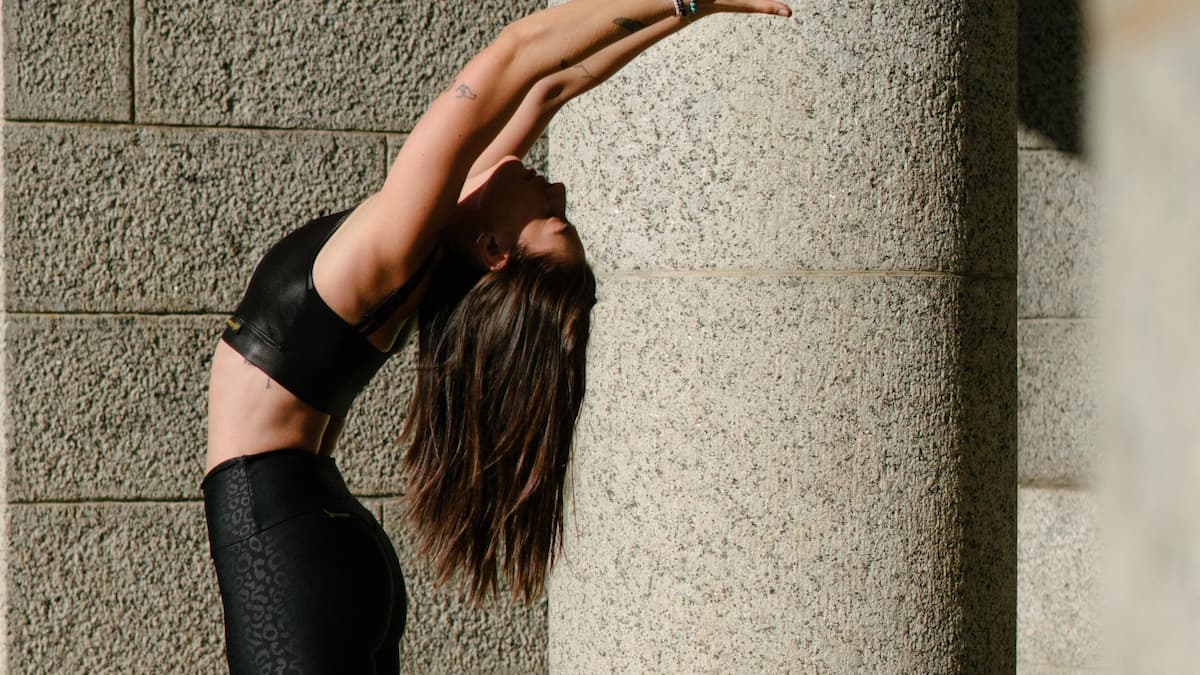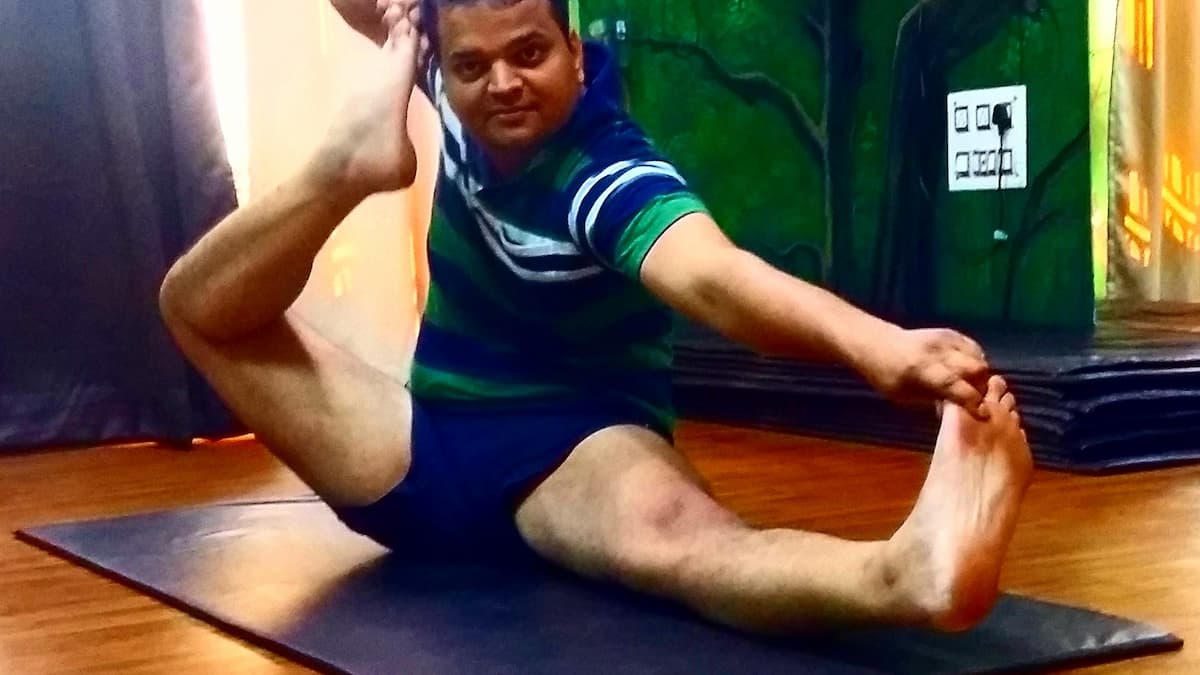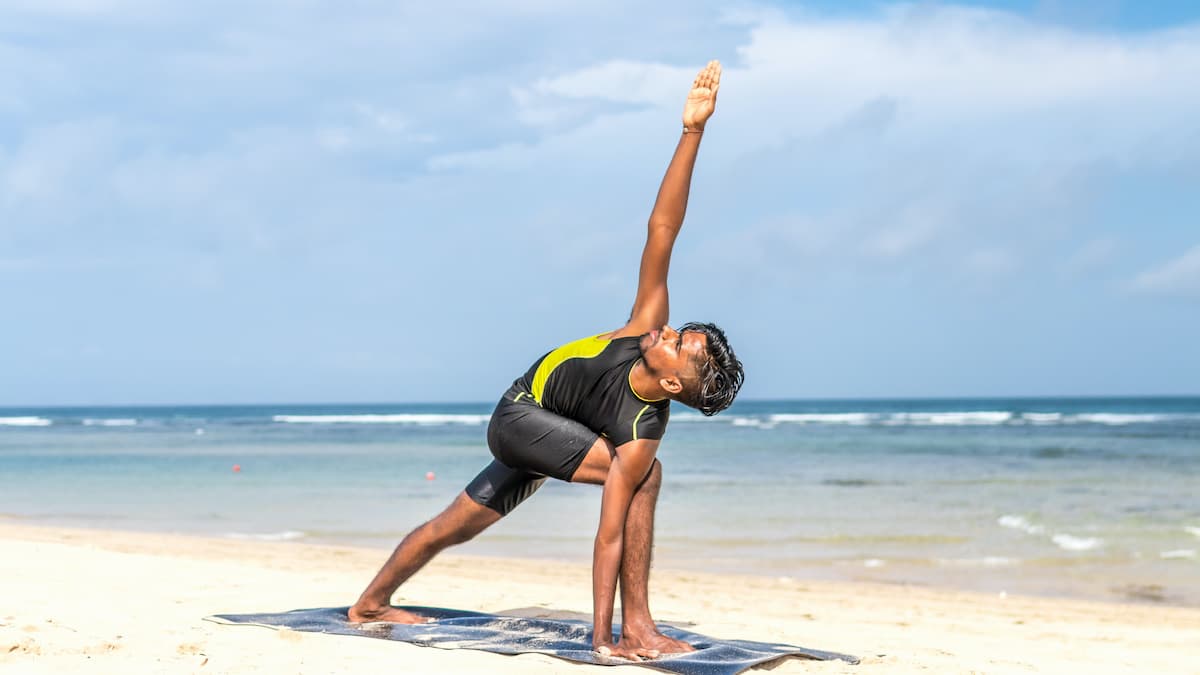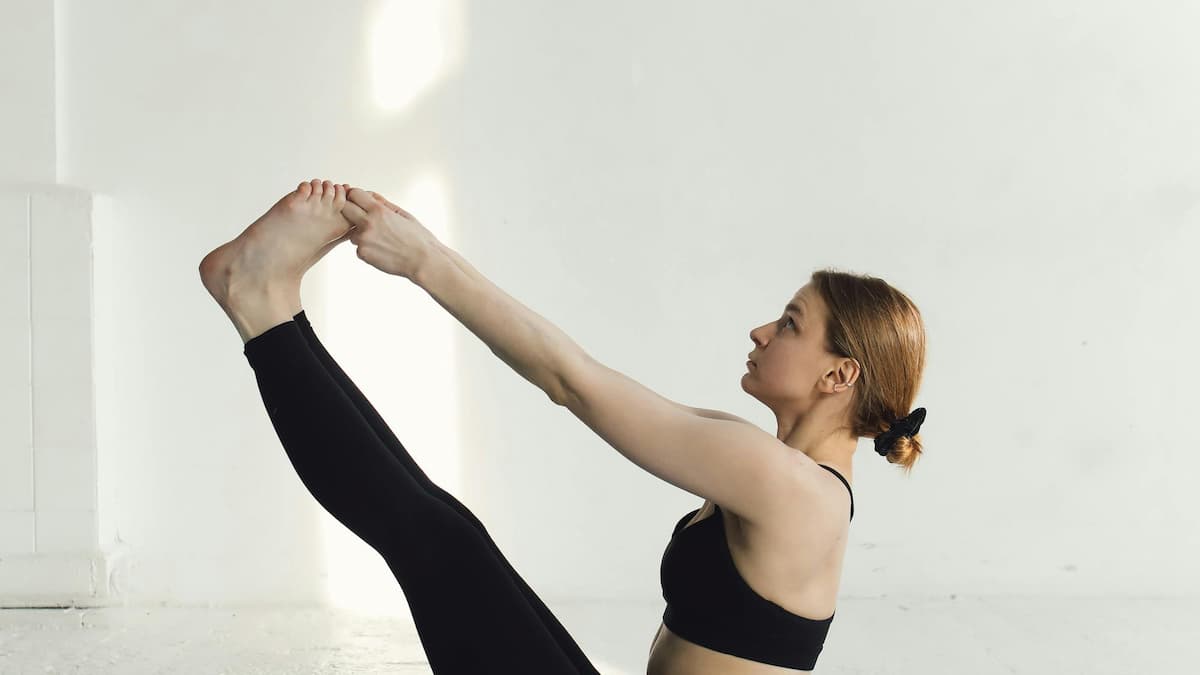Introduction
Yoga, an ancient discipline originating in India, unveils a treasure trove of physical and mental well-being through its diverse poses. Among these, Urdhva Hastasana stands as a simple yet profound cornerstone. This pose epitomizes the art of reaching towards the heavens. Beyond its physicality, this pose symbolizes an opening to positive energies and heightened consciousness. As we delve into the intricacies of this foundational posture, we unravel not just a physical stretch but a metaphorical gesture that has transcended centuries, encapsulating the essence of balance and harmony in the ancient practice of yoga.
This pose serves as a foundational pose in various yoga sequences, acting as a precursor to more complex postures. It is often incorporated in Sun Salutations (Surya Namaskar) and vinyasa flows, providing a seamless transition between poses. The pose is also used as a starting point for standing poses, inversions, and backbends, making it an integral part of a well-rounded yoga practice.
Urdhva Hastasana Information
| Pose Name | Urdhva Hastasana |
| Sanskrit Name | ऊर्ध्व हस्तासन |
| IAST | Ūrdhva hastāsana |
| English Name | Raised Hands Pose Upward Hands Pose or Upward Salute |
| Difficulty Level | Basic |
| Origin | Premodern |
| Type | Standing Yoga Poses |
Urdhva Hastasana Meaning
Urdhva Hastasana, a fundamental yoga pose, derives its name from the amalgamation of three Sanskrit words: “Urdhva,” “Hasta,” and “Asana.” In Sanskrit, “Urdhva” translates to “upward” or “elevated,” emphasizing the vertical extension inherent in the pose. “Hasta” signifies “hands,” alluding to the pivotal role of arm movement in this posture. Finally, “Asana” denotes “pose” or “posture,” encapsulating the overall stance. The synthesis of these terms captures the essence of Urdhva Hastasana as a dynamic and uplifting pose that involves extending the arms overhead, creating a seamless blend of physical movement, anatomical alignment, and the spiritual symbolism inherent in the language of yoga. Thus, this pose encapsulates not just a physical form but a holistic embodiment of upward-reaching energy within the yogic practice.
Upward Salute or Raised Hands Pose,
Urdhva Hastasana Procedure
Precautions and Contraindications
While Urdhva Hastasana (Upward Salute or Raised Hands Pose) is generally accessible to practitioners of various levels, it’s essential to consider certain precautions to ensure a safe and beneficial practice. Here are some precautions to keep in mind when practicing this pose:
- Warm-Up:
- Always begin your yoga session with a proper warm-up. This helps prepare your body for the stretches involved in Upward Salute Pose and reduces the risk of injury.
- Injury or Pain:
- If you have a shoulder, neck, or back injury, or if you experience pain while lifting your arms overhead, it’s advisable to consult with a healthcare professional or a qualified yoga instructor before attempting this pose.
- Pregnancy:
- Pregnant individuals should approach this pose with caution. Depending on the trimester, modifications may be necessary to accommodate the changing body. It’s recommended to seek guidance from a prenatal yoga instructor.
- Blood Pressure:
- Individuals with high blood pressure should be mindful while practicing this pose. The pose involves raising the arms overhead, which may affect blood pressure. If you have hypertension, consider modifying the pose or avoiding it altogether.
- Wrist Issues:
- If you have wrist issues or carpal tunnel syndrome, be cautious while bearing weight on your hands in this pose. Consider using props like blocks or modifying the hand position to alleviate wrist discomfort.
- Balance Issues:
- Practitioners with balance issues or dizziness should be mindful when transitioning into and out of this pose. Performing the pose near a wall or with the support of a chair can provide stability.
- Modifications:
- Don’t hesitate to use props like blocks or a chair to modify the pose, especially if you are a beginner or dealing with specific physical limitations. This ensures a gradual progression in your practice.
- Breathing Awareness:
- Maintain a conscious and steady breath throughout the pose. Avoid holding your breath, as proper breathing enhances the benefits and helps stabilize the body.
- Neck Strain:
- If lifting your gaze causes strain in the neck, keep your gaze forward or slightly downward. Avoid overextending the neck to prevent discomfort or injury.
- Gradual Progression:
- As with any yoga pose, progress gradually. Rushing into advanced variations without building a solid foundation can lead to strain or injury. Listen to your body and honor its limitations.
By observing these precautions, practitioners can enjoy the benefits safely, fostering a mindful and injury-free yoga practice. Always consult with a qualified yoga instructor or healthcare professional if you have specific concerns or health conditions.
Preparatory Poses
Preparatory poses play a crucial role in a yoga practice by warming up the body, increasing flexibility, and preparing it for more advanced postures like Raised Hands Pose. Including the following preparatory poses in your sequence can help enhance your practice of this pose:
Tadasana (Mountain Pose)
Tadasana is the foundational pose that encourages proper alignment and awareness of the body. It helps you establish a strong and grounded base before moving into Urdhva Hastasana
Neck Stretches
Gentle neck stretches help release tension in the neck and shoulders, which can be beneficial before lifting the arms overhead in Raised Hands Pose. Slowly tilt your head from side to side and forward and backward
Shoulder Rolls
Shoulder rolls help to loosen and warm up the shoulder joints. Rotate your shoulders in both directions, moving them forward and then backward, gradually increasing the range of motion.
Arm Swings
Swing your arms gently in circular motions to further warm up the shoulder muscles and improve flexibility in the arms.
Side Stretches
Perform gentle side stretches to lengthen the sides of the body. This helps create space in the ribcage, making it easier to lift the arms overhead.
Cat-Cow Stretch (Marjaryasana-Bitilasana)
This dynamic flow warms up the spine and improves flexibility. The movement between cat (rounded back) and cow (arched back) positions enhances mobility in the entire spine.
Downward-Facing Dog (Adho Mukha Svanasana)
Downward-Facing Dog is an excellent pose for stretching the entire body, especially the back, shoulders, and hamstrings. It builds strength in the arms and shoulders, preparing them for the overhead movement in Urdhva Hastasana.
Child’s Pose (Balasana)
Child’s Pose is a resting posture that helps stretch the back, hips, and shoulders. It also provides a moment of relaxation and centering before moving into Raised Hands Pose.
Cobra Pose (Bhujangasana)
Cobra Pose opens the chest and strengthens the back muscles, providing a good warm-up for Urdhva Hastasana. It also encourages a gentle backward bend, preparing the spine for the upright position.
Warrior Poses (Virabhadrasana I and II)
Warrior I and II help strengthen the legs, open the hips, and engage the core. These standing poses build stability and balance, creating a solid foundation for Urdhva Hastasana.
Incorporating these preparatory poses into your yoga practice can significantly enhance your ability to perform this pose with greater ease and awareness. Always listen to your body, and if you feel any discomfort or strain, modify the poses accordingly or seek guidance from a qualified yoga instructor.
Urdhva Hastasana Steps
Starting Position
- Firstly, begin in Tadasana (Mountain Pose), standing tall with your feet together and weight evenly distributed on both feet.
- Consequently, keep your arms by your sides, palms facing inward.
Inhale and Lift
- Inhale deeply simultaneously raising your arms overhead.
- Then, bring your palms together in a prayer position or keep them shoulder-width apart, fingers pointing towards the sky.
- Also, ensure that your biceps are close to your ears.
Engage the Body
- Then, activate your core muscles to maintain a straight and tall spine.
- Keep your shoulders relaxed and away from your ears.
Gaze Up and Hold the Pose
- If comfortable, lift your gaze towards your hands, allowing your neck to extend gently.
- Maintain the pose for 30 seconds to a minute, breathing deeply and evenly.
Release
- Exhale as you slowly lower your arms back to your sides.
Duration
The duration for holding Urdhva Hastasana, like any yoga pose, can vary depending on individual factors such as your experience, flexibility, and overall fitness level. However, a general guideline for holding this pose is to aim for 30 seconds to one minute.
Here’s a breakdown of the recommended duration:
- Beginners:
- If you are new to Urdhva Hastasana or yoga in general, start by holding the pose for about 30 seconds. This allows your body to get accustomed to the stretch without overexertion.
- Intermediate Practitioners:
- For those with some yoga experience and a comfortable familiarity with Urdhva Hastasana, aim to hold the pose for around 45 seconds to one minute. This duration allows for a deeper stretch and increased benefits.
- Advanced Practitioners:
- Advanced practitioners who are well-versed in Urdhva Hastasana can extend the duration to one minute or more. Holding the pose for an extended period can deepen the stretch and enhance the meditative aspect of the practice.
It’s essential to prioritize quality over quantity. Focus on maintaining proper alignment, engaging the necessary muscles, and connecting with your breath throughout the duration of the pose. If you feel any discomfort or strain, it’s advisable to release the pose earlier. Always listen to your body and avoid pushing yourself into a position that doesn’t feel right.
Incorporating this pose into a well-rounded yoga routine, including warm-up and cool-down sequences, contributes to a balanced practice. As with any yoga practice, consistency is key, and gradual progression over time can lead to improved flexibility, strength, and overall well-being. If you have any specific health concerns or conditions, consider consulting with a yoga instructor or healthcare professional for personalized guidance.
Follow Up Poses
Urdhva Hastasana Benefits
Stimulates the Nervous System
Urdhva Hastasana, the Raised Hands Pose, extends its impact beyond physical benefits, profoundly influencing the nervous system. As the body stretches upward, this foundational yoga pose stimulates the central nervous system, fostering mental clarity and focus. In essence, the intentional breathwork inherent in the pose regulates the autonomic nervous system, providing a calming effect that alleviates stress and anxiety. Simultaneously, the stretch promotes improved posture, intertwined with neurological well-being. Beyond these benefits, this pose induces a gentle massage to internal organs, enhancing circulation and autonomic function. Thus, the pose becomes a holistic practice, seamlessly connecting body and mind, offering not only physical flexibility but a profound and intricate relationship with the nervous system.
Opens the Chest and Lungs
This pose transcends its physical manifestation by actively opening the chest and lungs. As the arms gracefully ascend overhead, the ribcage expands, creating space for deeper breaths and increased lung capacity. This deliberate stretch not only enhances respiratory function but also promotes a sense of liberation in the chest, releasing tension and fostering a profound connection between breath and movement. Moreover, the expansive nature of this pose allows for optimal chest expansion, facilitating improved oxygenation and circulation throughout the body. This aspect of the pose not only contributes to respiratory health but also symbolizes an opening up to vitality and renewed energy, making it a vital element in the holistic practice of yoga.
Improves Posture
It extends its influence beyond the physical realm by significantly contributing to the improvement of posture. As the body gracefully extends with arms raised overhead, the spine undergoes a gentle elongation, promoting alignment and core engagement. Furthermore, this intentional stretch encourages the shoulders to relax and the chest to open, counteracting the effects of prolonged sitting and daily stresses that often contribute to poor posture. By consistently practicing this yoga pose, individuals can cultivate a heightened awareness of their spinal alignment, fostering the development of a strong and upright posture. This enhanced postural awareness not only benefits physical health by preventing strain and discomfort but also positively impacts mental well-being, as an upright posture is closely linked to increased confidence and a sense of empowerment.
Energizes the Body
The Upward Salute Pose emerges as a dynamic force in revitalizing the body. As practitioners extend their arms skyward in this yoga posture, a surge of energy courses through the entire system. Moreover, the stretch activates major muscle groups, awakening lethargic limbs and infusing the body with vitality. The pose serves as a catalyst for increased blood circulation, delivering fresh oxygen to cells and expelling stagnant energy. Beyond the physical, this pose enlivens the subtle energy pathways, or nadis, promoting a harmonious flow of prana. This heightened sense of energy not only fosters physical rejuvenation but also invigorates the mind, lifting spirits and infusing the practitioner with a renewed sense of dynamism, making this pose an essential component in the pursuit of holistic well-being.
Aids Digestion
The Raised Hands Pose extends its holistic benefits to encompass digestive well-being. As practitioners lift their arms overhead, this yoga posture engages the abdominal muscles and promotes a gentle compression of the digestive organs. Also, this intentional activation serves as a natural massage for the digestive tract, encouraging the efficient movement of food through the system. The stretch also stimulates the peristaltic action of the intestines, aiding in smooth digestion. The impact of this pose on the abdominal region contributes to relieving bloating and discomfort, fostering a more balanced digestive process. Regular practice of this pose can play a supportive role in maintaining digestive health, offering practitioners not only a physical stretch but a nourishing embrace for the entire gastrointestinal system, fostering harmony from within.
Enhances Concentration
The Upward Salute Pose emerges as a powerful catalyst for enhancing concentration. As practitioners lift their arms skyward, the intentional alignment and controlled breathing create a symbiotic flow between mind and body. Moreover, the stretch engages the entire spine, encouraging optimal blood circulation to the brain and invigorating cognitive functions. In essence, this heightened circulation, combined with the meditative quality of this pose, cultivates a focused and centered mental state. The deliberate and conscious nature of the pose prompts practitioners to draw inward, fostering mindfulness. Regular incorporation of this pose into a yoga practice not only strengthens the physical body but also serves as a mental sanctuary, refining the practitioner’s ability to concentrate, find clarity, and navigate the demands of everyday life with a heightened sense of awareness.
Conclusion
Urdhva Hastasana embodies the essence of reaching for the sky, both physically and metaphorically. As a fundamental yoga pose, it offers numerous benefits for the body and mind, making it a valuable addition to any yoga routine. Whether you are a beginner or an experienced yogi, practicing this pose regularly can contribute to overall well-being, flexibility, and a deeper connection to the self. So, raise your hands, breathe deeply, and let this pose guide you on your journey to balance and harmony.



